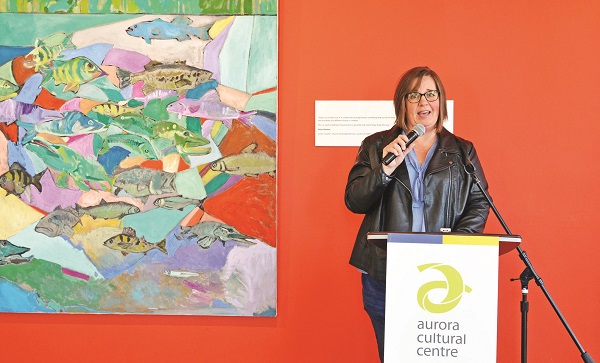General News » News
Last chance to see thought-provoking “Watershedsci” exhibition
April 25, 2019 · 0 Comments

By Brock Weir
Whether it is traditional paint, pieces created from debris found along the Lake Simcoe shoreline, or small pieces of fabric suspended from the ceiling to represent microplastics omnipresent in our water, Watershedsci has sparked no shortage of thought-provoking discussion.
Saturday, however, will be your last chance to see what people are talking about as Watershedsci, a unique environmental collaboration between the Simcoe Watershed Art Project and Lakehead University, prepares to leave the Aurora Cultural Centre.
The creators behind Watershed welcomed participating artists and art lovers alike to the Cultural Centre last Saturday for a special reception that shed light on the science that inspired the project.
“When Jenny Clark, founder of the Lake Simcoe Watershed Art Project, brought this exhibition to my attention, I was intrigued by the idea of artists responding to scientific research,” said Clare Bolton of the Aurora Cultural Centre. The result, as you can see, is an exceptional thought-provoking exhibition by outstanding artists working in a variety of mediums. I am grateful for the artists and scientists for using art as a vehicle for social change.
“I feel this exhibition has inspired visitors – young people, educators have come through the doors and the community at large – to start their own conversation about environmental concerns. I have learned since the opening of this exhibition [from] the educational school system that the conversation is happening [there] and that it is an integral part of their education. I am hopeful. There are some great things happening with the young people today. Exhibitions like this remind us of the challenges we face, but when we look at the creativity involved and the response to the scientific data that the scientists presented to the artists and worked with them. For me, it is essential for society to come up with innovative solutions for the challenges we face. This exhibition, and the response, gives me hope.”
It also gives hope to scientist Debbie Balika, Water Quality Specialist for Kawartha Conservation, who helped get this conversation started in the first place.
Ms. Balika became involved in the project while working at Lakehead University where she was asked to speak to Ms. Clark and participating artists about what they had in mind. What transpired, she said, was a great conversation that boiled down highlighting the art already existing in nature and melding these into a common vision.
“This Watershedsci project is very dear to my heart,” said Balika. “It really acts as a bridge for different conversations to occur, but it also allows for understanding and, at the end, what we all really want is action to happen. When people understand environmental issues and they understand impacts and are able to act on it, we couldn’t ask for a better flow.
“As we moved forward with this collaboration, we had a multitude of meetings. We had a lot of meetings to work out the details, our contributions, the artists and timelines, and the artists carried the lion’s share of the work. We spent an evening of learning and lectures…and then we sent all the artists home with thick wads of academic papers about different research on water quality issues. The topics we talked about that night, we really narrowed down to a focus on Lake Simcoe and Lake Couchiching because, as you know, we have a lot of water quality issues on a global level and we wanted to narrow down that scale.”
Some of the things talked about in relation to the two lakes were water quality monitoring, urban run-off, rural run-off and the dumping of nutrients into the water, e-coli, pesticides and biological invaders.
“After that night and after the artists had time to absorb all that knowledge and they chose a topic they wanted to focus on a little bit more, they were paired up with a Lakehead University scientist. I was lucky to be paired up with Jenny,” she continued. “She is just as excited as I was. It was a mutual excitement. We had lots of good and thoughtful conversations and discussions and what I took from it as a professional was I really increased my skill of making science accessible because it really needs to be understood in order to then share it with someone else.
“I feel the success of this exhibition itself is only a possibility because two different spheres came together and that is an art sphere and a science sphere. Both bodies were willing to look at things through different lenses and understand different perspectives. When we look through different lenses and we share perspectives, we can also make new perspective. The culmination of everyone’s passion and hard work is really evident today. Your work is creating new dialogue around the very thing that connects us all – water.”











